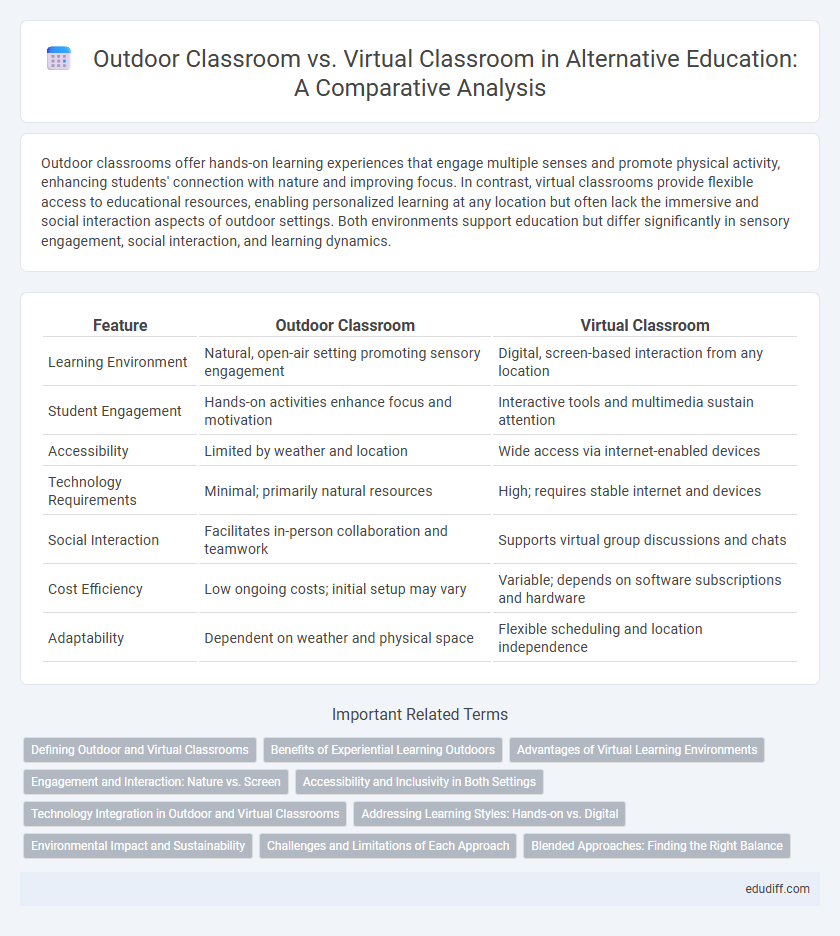Outdoor classrooms offer hands-on learning experiences that engage multiple senses and promote physical activity, enhancing students' connection with nature and improving focus. In contrast, virtual classrooms provide flexible access to educational resources, enabling personalized learning at any location but often lack the immersive and social interaction aspects of outdoor settings. Both environments support education but differ significantly in sensory engagement, social interaction, and learning dynamics.
Table of Comparison
| Feature | Outdoor Classroom | Virtual Classroom |
|---|---|---|
| Learning Environment | Natural, open-air setting promoting sensory engagement | Digital, screen-based interaction from any location |
| Student Engagement | Hands-on activities enhance focus and motivation | Interactive tools and multimedia sustain attention |
| Accessibility | Limited by weather and location | Wide access via internet-enabled devices |
| Technology Requirements | Minimal; primarily natural resources | High; requires stable internet and devices |
| Social Interaction | Facilitates in-person collaboration and teamwork | Supports virtual group discussions and chats |
| Cost Efficiency | Low ongoing costs; initial setup may vary | Variable; depends on software subscriptions and hardware |
| Adaptability | Dependent on weather and physical space | Flexible scheduling and location independence |
Defining Outdoor and Virtual Classrooms
Outdoor classrooms leverage natural environments for experiential learning, fostering direct engagement with the physical world to enhance sensory development and environmental awareness. Virtual classrooms utilize digital platforms and technologies to deliver interactive, remote education, enabling access to diverse resources and personalized learning experiences regardless of location. Both alternatives redefine traditional education by prioritizing flexibility, accessibility, and varied teaching methodologies tailored to different learning needs.
Benefits of Experiential Learning Outdoors
Experiential learning outdoors enhances student engagement by providing hands-on activities that connect theoretical knowledge to real-world experiences. Outdoor classrooms promote physical activity and sensory stimulation, which improve cognitive function and retention rates. Exposure to natural environments also fosters social skills, creativity, and environmental stewardship among students.
Advantages of Virtual Learning Environments
Virtual learning environments provide unmatched flexibility by enabling students to access coursework anytime and anywhere, which enhances personalized pacing and accommodates diverse learning styles. Interactive tools such as quizzes, forums, and multimedia content foster greater engagement and collaboration compared to traditional outdoor classrooms. Cost efficiency and scalability make virtual classrooms an ideal solution for institutions aiming to expand access without the logistical constraints of physical spaces.
Engagement and Interaction: Nature vs. Screen
Outdoor classrooms foster higher levels of engagement and interaction by immersing students in a dynamic natural environment that stimulates curiosity and hands-on learning. Virtual classrooms rely on digital tools and screens, which can limit sensory experiences but offer interactive features such as polls, chats, and breakout rooms to maintain student participation. Studies show that outdoor learning enhances social skills and environmental awareness, while virtual learning emphasizes technological proficiency and can reach a wider audience.
Accessibility and Inclusivity in Both Settings
Outdoor classrooms enhance accessibility by engaging students with diverse learning needs through sensory-rich environments and flexible physical activities, promoting inclusivity beyond traditional seating arrangements. Virtual classrooms offer inclusivity by providing adaptive technologies, such as screen readers and closed captioning, accommodating students with disabilities and varying schedules. Both settings require tailored approaches to ensure equitable participation and access to learning resources for all students.
Technology Integration in Outdoor and Virtual Classrooms
Technology integration in outdoor classrooms leverages mobile devices, augmented reality (AR), and sensor-based tools to create immersive and interactive learning experiences that connect students with the natural environment. Virtual classrooms utilize advanced video conferencing platforms, digital collaboration tools, and AI-driven personalized learning systems to facilitate real-time engagement and adaptive instruction across diverse geographic locations. Both modalities enhance educational outcomes by combining experiential learning with cutting-edge technology, fostering deeper understanding and skill development.
Addressing Learning Styles: Hands-on vs. Digital
Outdoor classrooms cater effectively to kinesthetic and tactile learners by providing hands-on experiences that enhance engagement and retention through direct interaction with natural environments. Virtual classrooms excel in supporting visual and auditory learners by integrating multimedia content, interactive simulations, and real-time feedback that adapt to various digital learning preferences. Balancing outdoor tactile activities with virtual digital tools creates a comprehensive educational approach that addresses diverse learning styles and maximizes student potential.
Environmental Impact and Sustainability
Outdoor classrooms significantly reduce energy consumption by eliminating the need for electronic devices and artificial lighting, contributing to lower carbon footprints compared to virtual classrooms reliant on data centers and digital infrastructure. Natural ventilation and sunlight in outdoor settings minimize greenhouse gas emissions, enhancing sustainability efforts. While virtual classrooms reduce physical resource use such as paper, their substantial energy demand for servers and network operations presents ongoing environmental challenges.
Challenges and Limitations of Each Approach
Outdoor classrooms face challenges such as weather dependency, limited technological resources, and potential distractions from the environment, which can hinder consistent lesson delivery. Virtual classrooms encounter limitations including digital divide issues, decreased student engagement, and challenges in fostering social interaction, impacting the overall learning experience. Both approaches demand tailored strategies to address these drawbacks while maximizing educational outcomes.
Blended Approaches: Finding the Right Balance
Blended approaches combine the immersive experience of outdoor classrooms with the flexible accessibility of virtual classrooms, enhancing student engagement and learning outcomes. Outdoor environments promote hands-on, experiential learning that boosts creativity and social skills, while virtual platforms provide customizable content and real-time collaboration across distances. Finding the right balance involves integrating outdoor activities with digital tools to support diverse learning styles and foster a comprehensive educational experience.
Outdoor Classroom vs Virtual Classroom Infographic

 edudiff.com
edudiff.com